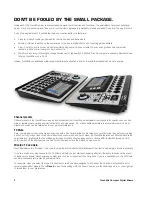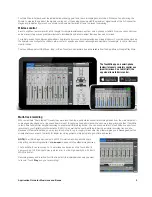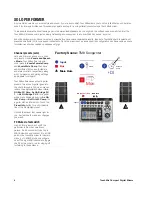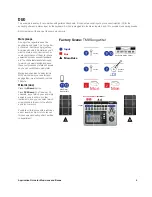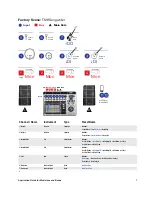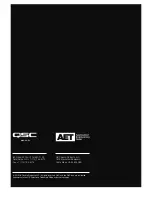
6
TouchMix Compact Digital Mixers
SMALL GROUP
Factory scene:
TM8 Songwriter
3L[»ZL_WSVYL;V\JO4P_»ZZJLULJHWHIPSP[PLZ;OLTP_LYJVTLZ^P[OZL]LYHSMHJ[VY`PUZ[HSSLKZJLULZ[OH[`V\JHU\ZLHZL_HTWSLZVM
OV^P[JHUILJVUÄN\YLKVYHZZ[HY[PUNWVPU[ZMVYHYYP]PUNH[`V\YV^UTP_TVYLX\PJRS`
The scenario:
(MV\YWLYZVUNYV\WJVTWYPZPUNHTHSLHUKHMLTHSL]VJHSPZ[·LHJOVM^OVTWSH`HJV\Z[PJN\P[HY·HSVUN^P[OHULSLJ[YPJIHZZHUK
HWLYJ\ZZPVUPZ[WSH`PUNJVUNHZ
This calls for the scene
TM8 Songwriter
:JLULZHYLHJJLZZPISLMYVT[OLTLU\ZJYLLUVYI`[V\JOPUN[OLI\[[VUH[[OL\WWLYYPNO[
VM[OLOVTLZJYLLU;OLZJLULW\SSZ\W[OLZLWYLZL[ZOPNOSPNO[LKVU[OLZJYLLUPUJ`HU
;OPZZJLULHUKV[OLYZHYLTLHU[[VVќLY`V\HX\PJRZ[HY[PUNWVPU[^P[OZVTLZ\NNLZ[LKZL[[PUNZ(Z`V\JHUZLLV[OLYZPTPSHY
WYLZL[ZHYLH]HPSHISLHUK`V\JHUM\SS`[HPSVYHSSZL[[PUNZHUKZH]L[OLT[VPU[LYUHSTLTVY`VYL_[LYUHSZ[VYHNLHZHUL^ZJLUL
;OLMHJ[VY`ZJLULKVLZUV[PUJS\KLHU`LќLJ[ZZL[[PUNZI\[`V\HYLMYLL[VTHRLM\SS\ZLVM[OLVUIVHYKKPNP[HS-?WYVJLZZPUN
;OLZLZL[[PUNZHYLZH]LK[VHU`ZJLULZ[OH[`V\JYLH[L-VYL_HTWSL]VJHSZ\Z\HSS`ILULÄ[MYVTZVTLHKKLKHTIPHUJL
Z\JOHZYL]LYI
7YVÄSL!;OL7LYMVYTPUN:PUNLY:VUN^YP[LY
<ZLY7YVÄSL
The user is a musician performing solo or in a smaller group in a variety of smaller venues. Even at lower volume levels the expectations are high for quality sound and
production value.
The Problem
“I record my songs with my DAW at home and I have lots of EQ, compressors and effects available so I can get things to sound the way I want them to. But when I play out
live, I just can’t get the sound I want. I don’t play that loud but even so, I’m always
fi
ghting with feedback and boomy sounding acoustic guitar.”
“Speaking of recording, I’d really like to record my live performances but when I hook a recorder up to the stereo output on my little analog mixer, it just doesn’t sound very
good. How can I get great sounding live recordings?”
“I suppose I could get one of those high-end digital mixers with all the EQ and effects built in, but they’re too big, too expensive and I don’t really know how to run everything.”
The Solution
Getting great live sound for an “unplugged” performance takes more technology than one would think plus a good deal of expertise to make it all work. Fortunately QSC has
included both the technology and the expertise in the TouchMix.
•
All the signal processing capability you need to sound like a concert artist. While the TouchMix is about the size of a laptop computer, every channel has EQ and dynamics
processing (compressor and gate) like that found on large concert sound consoles. And there are four on-board effects processors modeled after the “go-to” processors
concert engineers rely on.
•
Built-in expertise. You might not be a seasoned concert sound guy but the TouchMix will help you sound like one. It includes over one hundred channel presets that
were carefully tuned to work in live sound situations with typical instruments and microphones. Not sure what effect to use? There’s an FX Wizard that helps you through
the process of selecting and routing just the right reverb, delay, chorus or pitch change for every instrument or singer on your stage. Confused about setting input and
output gain? There’s a Gain Wizard to help with the inputs and a built-in aid for matching the output level with QSC powered speakers and ampli
fi
ers.
•
How about recordings that combine the energy of a live performance with the quality of a studio session? Ever have one of those nights where you’re playing your best
and wished you had a recording? The TouchMix makes it easier than ever to capture a live performance to multi-track. All you need is a quali
fi
ed USB hard-drive. After
the gig you can mix down right on your TouchMix or import the tracks to your favorite DAW software.
Serving Suggestion
The following stage plot for an ‘unplugged’ group based on the TouchMix factory
scene “TM8 Songwriter”.
Using the Factory Scene
Your group is probably not exactly like this one so you may need to make
some changes to the scene.
•
Recall the appropriate channel presets to match your instrumentation.
•
Go to the FX Wizard (
Wizard > FX Wizard
), then select and assign effects.
•
Go to the Aux Output Set tab and name your monitor outputs.
Why?
As you use the presets, you may see and hear some things that seem a bit unusual.
•
The low frequencies are rolled off in many of the instrument presets. That’s
because only a few instruments (for example, bass and kick drum) really
produce desirable bass in a live setting. For other instruments, rolling off the
lows gets rid of rumble, boominess, and low frequency feedback.
As a result, the bass that belongs in your mix will be clear and articulate.
•
Important:
With the presets, some instruments may sound a bit thin by
themselves. But the important thing is how the instrument sits in the overall mix.


